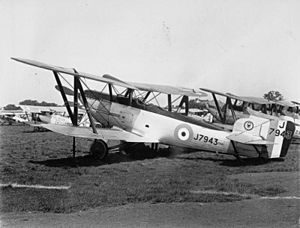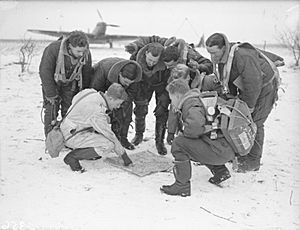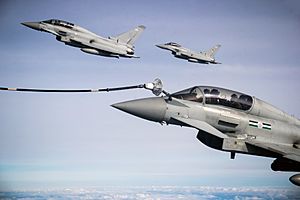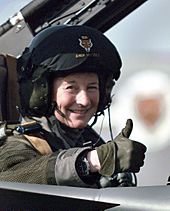No. 12 Squadron RAF facts for kids
Quick facts for kids No. 12 (B) Squadron RAF |
|
|---|---|
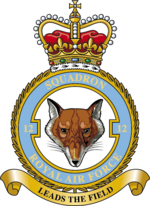
Squadron badge
|
|
| Active | 14 February 1915 – 1 April 1918 (RFC) 1 April 1918 – 27 July 1922 (RAF) 1 April 1923 – 13 July 1961 1 July 1962 – 31 December 1967 1 October 1969 – 31 March 2014 9 January 2015 – 14 February 2018 24 July 2018 – present |
| Country | |
| Branch | |
| Type | Joint British/Qatari training squadron |
| Role | Multi–role combat |
| Part of | No. 1 Group RAF |
| Home station | RAF Coningsby |
| Nickname(s) | 'Shiny Twelve' |
| Motto(s) | "Leads the Field" |
| Aircraft | Eurofighter Typhoon FGR4/T3 |
| Battle honours |
|
| Insignia | |
| Squadron badge | A fox's mask |
| Squadron badge heraldry | Based on a suggestion when the squadron was equipped with the Fairey Fox, an aircraft of which they were the sole operators. Approved by King George VI in February 1937. |
| Squadron roundel |  |
| Squadron codes | QE (Apr 1939) PH (Sep 1939 – Apr 1951) GZ (Nov 1942 – Jul 1946) FA–FZ (Aug 1985 – Apr 1996) |
No. 12 Squadron, also called No. 12 (Bomber) Squadron, is a special flying team in the Royal Air Force (RAF). In July 2018, the squadron was restarted as a joint team with the Qatar Emiri Air Force. It is currently based at RAF Coningsby in Lincolnshire. The squadron flies the Eurofighter Typhoon FGR4. It also helps train Qatari air and ground crews. This training is part of Qatar buying 24 Typhoons from the UK.
History of No. 12 Squadron
The World Wars: Early Flights and Brave Missions
No. 12 Squadron of the Royal Flying Corps (RFC) started in February 1915. It was formed from a small group of No. 1 Squadron RFC at Netheravon Airfield. In September 1915, the squadron moved to France. They flew many different aircraft over the Western Front during the First World War. In March 1918, they got new Bristol F.2b Fighter planes. Soon after, they became part of the new Royal Air Force. The squadron was based in Bickendorf, Germany, and was closed down in 1922.
The squadron started again on April 1, 1923, at RAF Northolt. They flew the de Havilland DH.9A. In 1924, they moved to RAF Andover and switched to the Fairey Fawn, a bomber plane. In 1926, the Fawns were replaced by the Fairey Fox. This plane influenced the squadron's badge, which features a fox's head. No. 12 Squadron was the only RAF team to use the Fairey Fox. Its excellent performance led to their motto: 'Leads the Field'. In 1931, they got Hawker Hart planes. They moved to Aden in October 1935, but came back to Andover in August 1936. The Harts were replaced by the Hawker Hind in 1936, and in 1938, they received Fairey Battles.
Courageous Attack on the Albert Canal
On the first day of World War II, the squadron moved to France to start missions. On May 12, 1940, a bridge over the Albert Canal in Belgium was important for the invading German Army. This bridge was heavily protected. The RAF was ordered to destroy it. Five Fairey Battles from No. 12 Squadron were sent for this dangerous mission.
At Amifontaine, six Battles from 12 Squadron were told to attack bridges near Maastricht. The day before, Belgian planes had been shot down attacking similar targets. The commander asked for volunteers, and every pilot stepped forward. Six crews were chosen. Other squadrons were supposed to help by distracting German fighters.
Two Battles from A Flight took off at 8:00 a.m. They flew high, but 15 miles from Maastricht, they faced heavy anti-aircraft fire. German fighters attacked, and several planes were shot down. The Battles dove from 6,000 feet and dropped bombs at 2,000 feet. Both planes were hit. One crashed, and its crew was captured. The second plane, though damaged, managed to drop its bombs. It was hit again by a German fighter, but the rear gunner fought back. The plane caught fire, but the pilot put it out and flew home, landing safely in a field.
Five minutes later, B Flight attacked another bridge. They flew very low. One Battle was hit and crashed before reaching the target. Another was hit, exploded, and its crew died. The third Battle dove straight into the bridge, destroying its western end. German engineers quickly started building a new bridge.
The attack faced strong enemy fire, but the mission was successful. Much of this success was thanks to the bravery of Flying Officer Garland and Sergeant Gray. Sadly, their plane and three others did not return. Flying Officer Garland and Sergeant Gray were both given the Victoria Cross medal after they died, for their incredible courage.
No. 12 Squadron returned to England in June 1940. They were first at RAF Finningley, then moved to RAF Binbrook in July 1940. They got new Battles. The squadron attacked German ships in Boulogne Harbour. They were one of the last No.1 Group teams to use Fairey Battles. By November 1940, they had new Vickers Wellington medium bombers. In 1942, they moved to RAF Wickenby and soon started flying the Avro Lancaster heavy bomber.
Cold War Era: Jet Bombers and Nuclear Missions
In 1946, No. 12 Squadron got the Avro Lincoln, another heavy bomber. In 1952, they entered the jet age with the English Electric Canberra jet bomber. After 44 years of continuous service, the squadron was closed down on July 1, 1961.
On July 1, 1962, the squadron was restarted. They flew eight Avro Vulcan V bombers. These planes carried Yellow Sun nuclear bombs. The squadron first operated Vulcans from RAF Coningsby, then from RAF Cottesmore. As enemy missiles became better, high-flying bombers were at risk. In 1966, the squadron received WE.177B nuclear bombs for low-level missions. They stopped this role on December 31, 1967. The squadron was then planned to fly the BAC TSR-2 and later the General Dynamics F-111K, but these plans were cancelled.
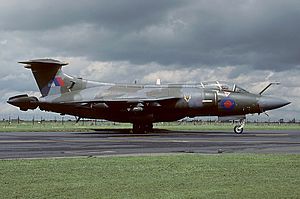
No. 12 Squadron finally restarted at RAF Honington on October 1, 1969. They had twelve Blackburn Buccaneer aircraft. Their job was to attack ships. They carried WE.177 nuclear bombs and regular bombs. From 1974, they also used Martel missiles for non-nuclear attacks.
In the late 1970s, the squadron was featured in an RAF film called 12 Squadron Buccaneers. The film showed the squadron moving from Honington to RAF Gibraltar for a NATO exercise. They performed a low-level anti-shipping mission. In 1980, the squadron moved to RAF Lossiemouth, still focusing on anti-shipping roles.
Gulf War and Beyond
During the 1991 Gulf War, members from all three Buccaneer squadrons at Lossiemouth, including No. 12 Squadron, took part in Operation Granby. This was the Buccaneer's first combat mission. They quickly prepared six aircraft in under 72 hours. These planes were painted desert-pink and got extra war equipment. The first six planes left Lossiemouth for Muharraq in Bahrain on January 26, 1991.
Twelve Buccaneers helped by marking targets with lasers. Often, an attack group had four Tornados and two Buccaneers. Each Buccaneer carried a Pave Spike laser designator pod. The Buccaneer force was called the 'Sky Pirates' because of the Buccaneer's naval history. Each plane had a Jolly Roger flag painted on it. They were also named after Speyside whisky, like Glenfiddich. The war ended in late February 1991. The Buccaneers flew 218 missions without losing any planes. They marked targets for other aircraft and later dropped 48 Paveway II laser-guided bombs. In October 1993, the squadron stopped using its Buccaneers.
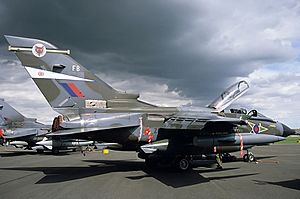
In September 1993, No. 27 Squadron became No. 12 (B) Squadron. They moved to RAF Lossiemouth and started flying twelve Panavia Tornado GR1B aircraft. They were equipped with eighteen WE.177 nuclear weapons.
In December 1998, the squadron took part in Operation Desert Fox, an air campaign against Iraq. They continued to deploy to the Persian Gulf. They flew the upgraded Tornado GR4 from 2001. This included major help in 2003 for Operation Telic. They also supported the first free elections in Iraq in January 2005. In 2006 and 2008, No. 12 (B) Squadron provided air support for UK and US ground operations in Iraq. When British troops left Iraq, the Tornado planes also returned to the UK.

In June 2009, the squadron sent ten jets to RAF Akrotiri, Cyprus. Eight of these went on to Kandahar in Afghanistan. This marked the start of Tornado GR4 missions in Afghanistan. The Tornado replaced the Harrier GR9 there. For over four months, No. 12 (B) Squadron helped the International Security Assistance Force (ISAF). This included close air support for British, American, Canadian, and Afghan troops. On October 16, 2009, No. 12 (B) Squadron returned to Lossiemouth.
Between missions in Afghanistan in 2011, No. 12 (B) Squadron also helped in Operation Ellamy. This was the UK's part in the military action in Libya. Ten aircrew went to Gioia del Colle Air Base in Italy to help with Tornado operations. The rest of the squadron was ready to launch Storm Shadow attacks on strong Libyan targets. These missions needed several air-to-air refuelings. No. 12 (B) Squadron had their last tour of Afghanistan from July to October 2013. They were replaced by No. 617 Squadron. The squadron was closed down on March 31, 2014.
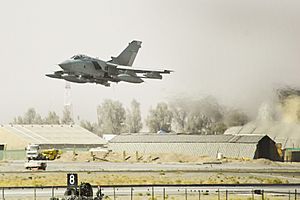
All Tornado aircraft were planned to stop flying for the RAF by the end of 2015. However, in October 2014, Prime Minister David Cameron announced that Tornados would continue to support operations against ISIL. So, No. 12 (B) Squadron was restarted on January 12, 2015, at RAF Marham. They took over the Tornado planes from No. II (AC) Squadron. Wing Commander Nikki Thomas became the commander. She was the first female RAF officer to lead a fast jet squadron.
In August 2015, it was reported that the squadron would stay active longer. They were sent to Syria to scout for ISIS troop movements. The squadron's last mission with the Tornado was on December 14, 2017, over Iraq and Syria. As the RAF reduced its Tornado fleet, the squadron was closed down on February 14, 2018. This was 103 years after it first formed. Squadron members were moved to other Tornado squadrons.
Eurofighter Typhoon: The Current Chapter (2018–Present)
On December 14, 2017, the Ministry of Defence announced that No. 12 Squadron would fly the Eurofighter Typhoon. They would also temporarily include Qatari air and ground crews. This is to provide training as part of Qatar's purchase of 24 Typhoons. The squadron restarted on July 24, 2018, as a joint RAF/Qatar Emiri Air Force (QEAF) unit. No. 12 (B) Squadron received its first Typhoon FGR4 in July 2019 at RAF Coningsby. In November 2019, No. 12 Squadron went to Qatar. They took part in Exercise Epic Skies III with the QEAF for three weeks.
Aircraft Operated by No. 12 Squadron
- Avro 504 (1915)
- Martinsyde S.1 (1915)
- Morane-Saulnier H (1915)
- Voisin LA (1915)
- Royal Aircraft Factory BE.2b (1915)
- Royal Aircraft Factory BE.2c (1915–1917)
- Royal Aircraft Factory RE.7 (1915–1916)
- Royal Aircraft Factory RE.5 (1915–1916)
- Bristol Scout (1915–1916)
- Morane-Saulnier LA (1915–1916)
- Royal Aircraft Factory FE.2b (1916)
- Morane-Saulnier BB (1916)
- Royal Aircraft Factory BE.2d (1916–1917)
- Royal Aircraft Factory BE.2e (1916–1917)
- Royal Aircraft Factory RE.8 (1917–1919)
- Bristol F.2B Fighter (1918–1922)
- Airco DH.9A (1923–1924)
- Fairey Fawn (1924–1926)
- Fairey Fox (1926–1931)
- Hawker Hart (1931–1936)
- Hawker Hind (1936–1938)
- Fairey Battle (1938–1940)
- Vickers Wellington II (1940–1942)
- Vickers Wellington III (1942)
- Avro Lancaster I & III (1942–1946)
- Avro Lincoln B.2 (1946–1952)
- English Electric Canberra B.2 (1952–1955)
- English Electric Canberra B.6 (1955–1961)
- English Electric Canberra B.2 (1957–1959)
- Avro Vulcan B.2 (1962–1967)
- Hawker Siddeley Buccaneer S.2B (1969–1993)
- Panavia Tornado GR1B (1993–2001)
- Panavia Tornado GR4 (2001–2018)
- Eurofighter Typhoon FGR4 (2019–present)


